
Churches - Bevendean History Project

St Saviours Church, Ditchling Road, BrightonThere
had been very little housing development beyond the old parish
boundaries of Brighton before 1870, however, with the building of the
Roundhill estate which started in the 1850's together with the building
of smaller properties near the railway by 1870, the Vicar of Preston
and Hove realised the need for a church in that area.
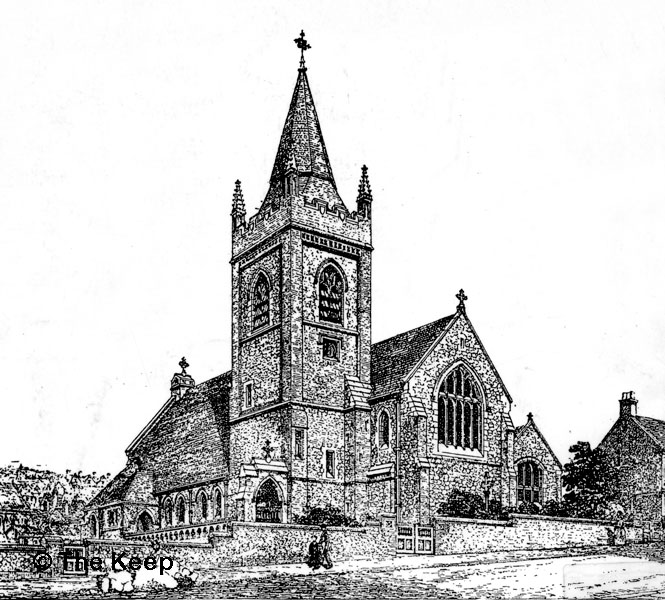
A drawing showing the proposed church of St Saviour in Ditchling Road showing the church tower which was never built.
Ref: BHBox7b - © The Keep
St Saviour’s Church was built on a site donated by Mr Vere Fane Bennett-Stanford of Preston Manor, to the designs of Edmund Scott and F T Cawthorn of Regency Square, Brighton.
Here are the plans for St Saviours Church in Ditchling Road dated 24 February 1885.
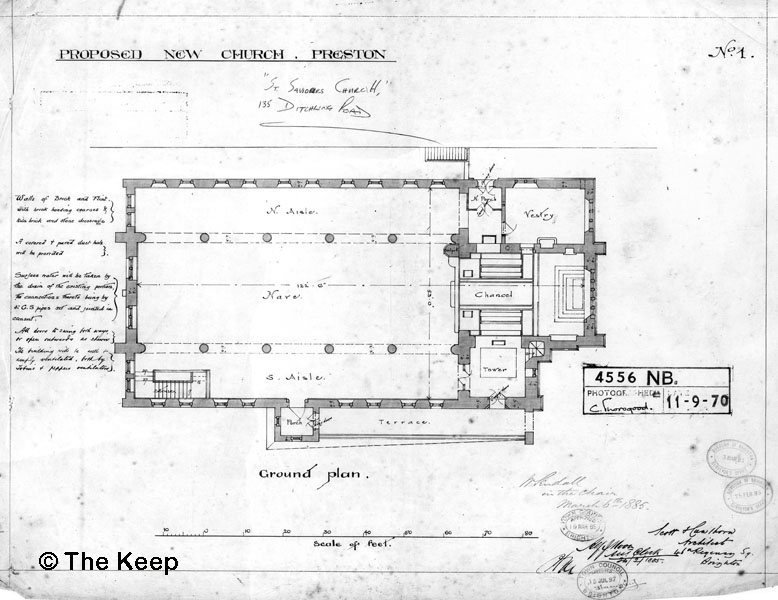
Ground Plan for Proposed New Church in the Parish of Preston.
Ref: DB/D/134/4556
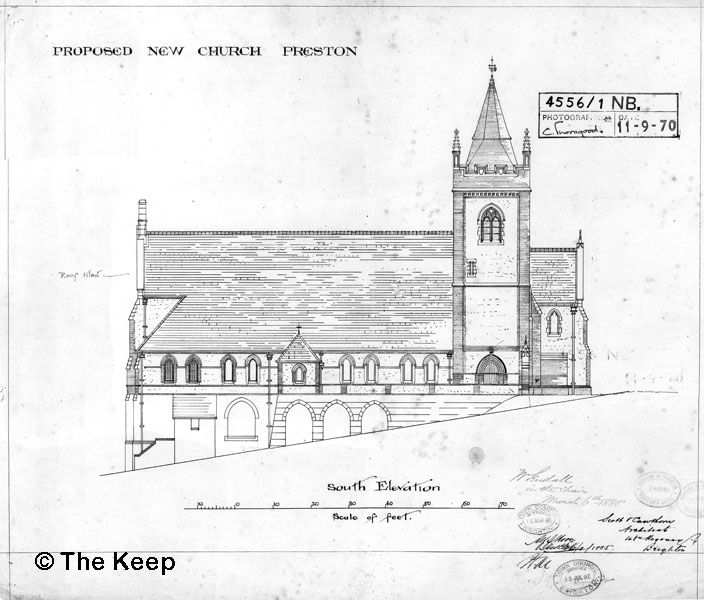
South Elevation for Proposed New Church in the Parish of Preston.
Ref: DB/D/134/4556-1
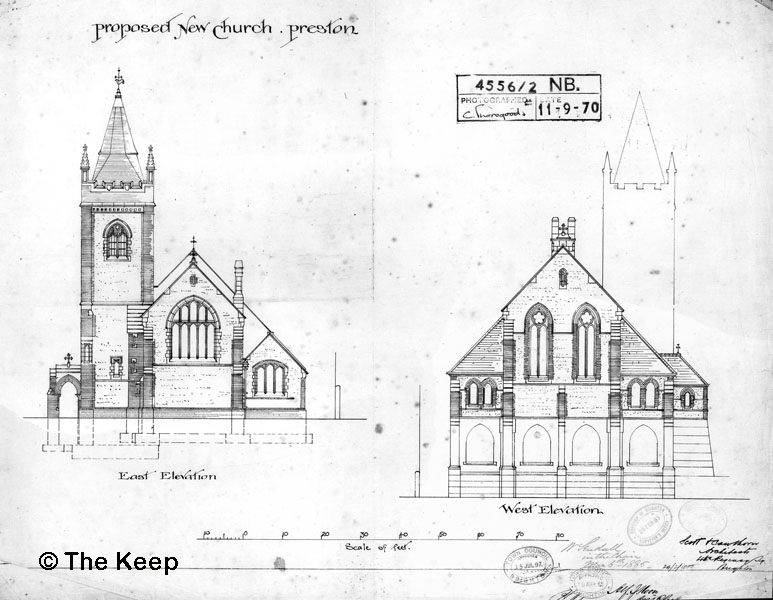
East and West Elevations for Proposed New Church in the Parish of Preston.
Ref: DB/D/134/4556-2
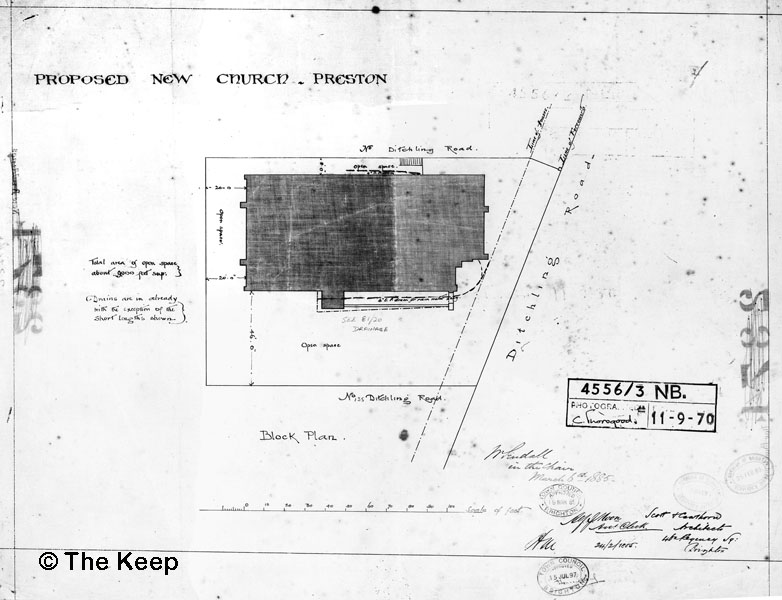
Site Plan for Proposed New Church in the Parish of Preston.
Ref: DB/D/134/4556-3
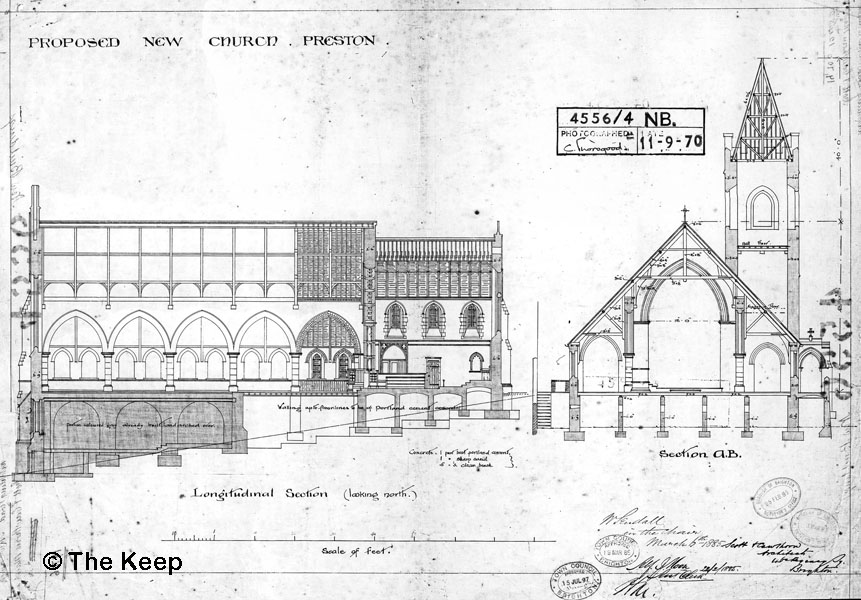
Section Plans for Proposed New Church in the Parish of Preston.
Ref: DB/D/134/4556-4
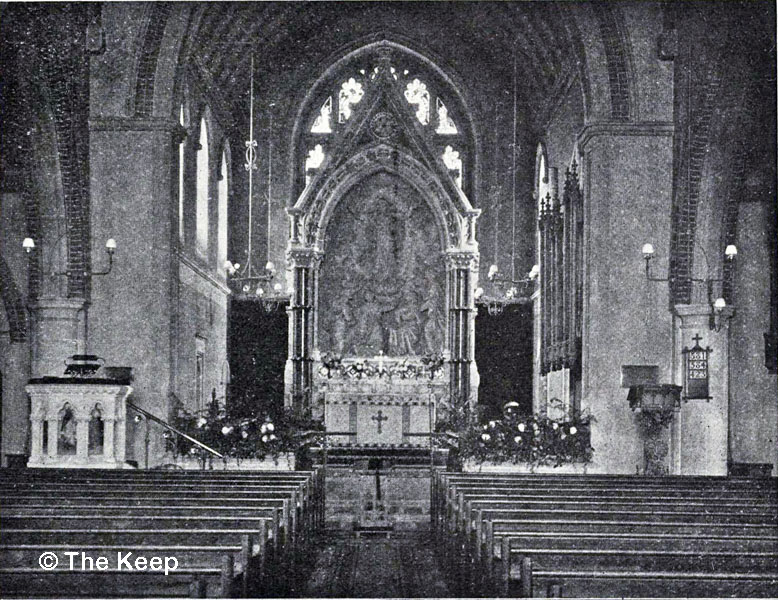
St Saviours Church viewed towards the Sanctuary c1915.
Ref: 1915-06_B&H Parochial Gazetteer
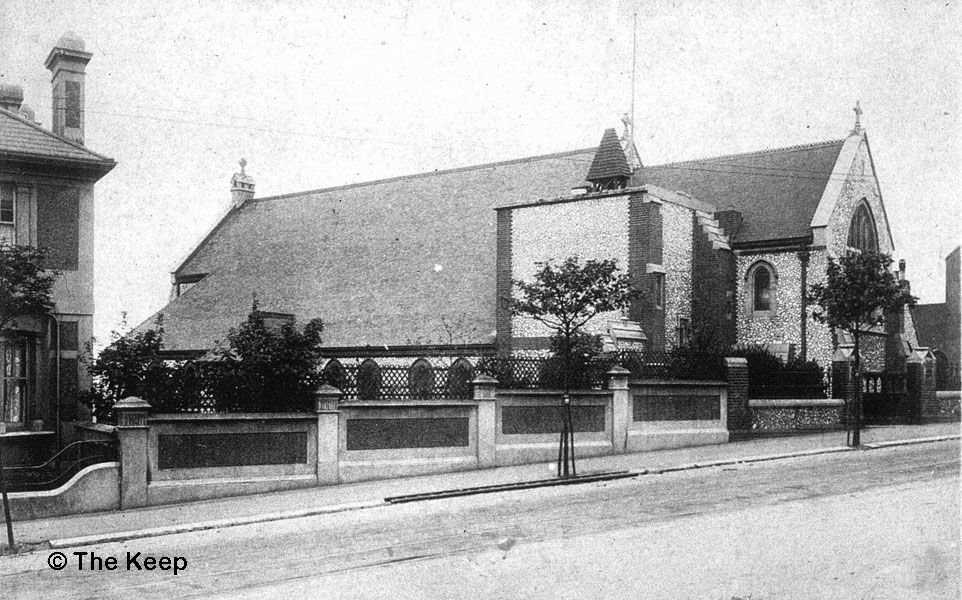
St Saviours’ Church viewed looking up Ditchling Road c1930 showing the squat tower.
A building committee raised £1,500 and constructed a crypt on the lower part of the site, where the first service was held on 17 July 1881.
Further work on the church was delayed but the foundation stone was laid on 19 August 1885, the nave and aisles were constructed in 1886, and the chancel was completed in 1889.
On Thursday 25 November 1886, the Bishop of Chichester consecrated the nave and aisles of the building and celebrated Holy Communion in the course of a service described as very long.
The six hundred seats in the new church were well filled and the collection amounted to £90, but it is worth noting that the number of communicants was just 78. A site near the foot of Ditchling Rise was acquired for a hall and adjacent mission house. These extensive premises were opened by the Bishop of Chichester in March 1887 and rapidly became a focus of community activities for more than fifty years.
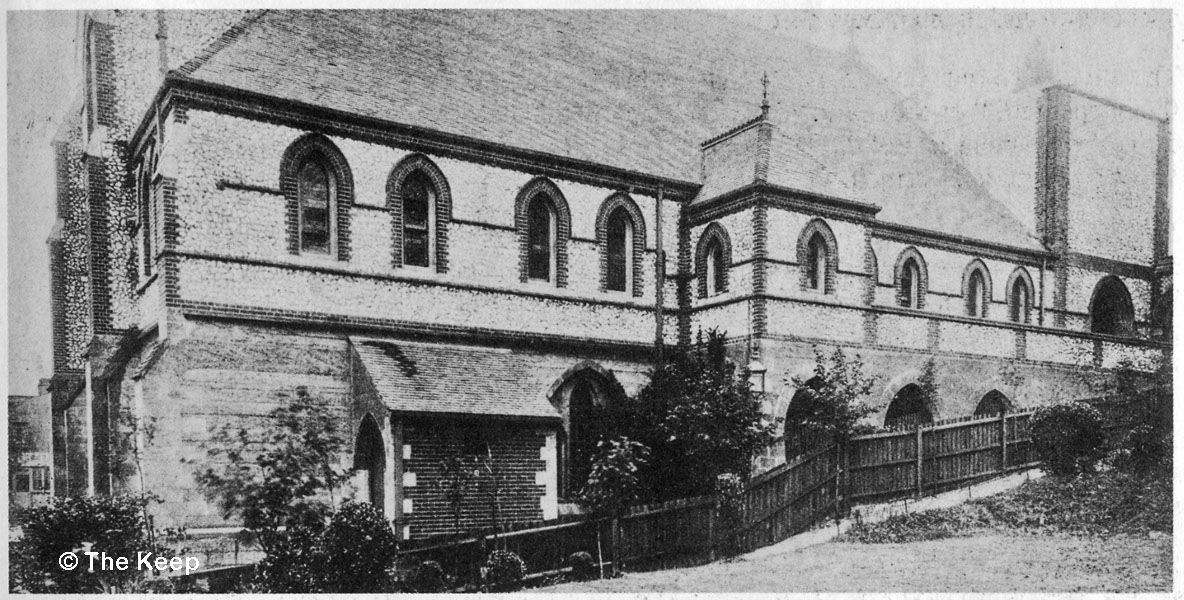
St Saviours’ Church south side c1930.
St. Saviour's, unlike many other Victorian churches, did not have a single benefactor to erect and endow the building. The people living in the area were not wealthy and were unable to donate the large sums of money needed to complete the work.
Queen Victoria's Jubilee in June 1887 was the occasion for a special service and the church's first confirmation took place in December 1887. The five bays of the nave and aisles were closed at the east end by a temporary brick wall. By 1889 another building committee had been formed to initiate the completion of the Chancel, vestry and tower. The Chancel was finally consecrated in 1899.
St. Augustine's, begun in 1894 in an iron building only one-third of a mile away on the more fashionable side of the railway had serious consequences for the funding of the St Saviours church and from this period onwards the burden of debt loomed up to the 1930s.
The children in particular seem to have been vigorous fund raisers for the new church. Their efforts provided over the years the bell, the font and nearby window and brass fittings for the pulpit. The most outstanding gift by children of the Sunday School was the east window for the newly completed Chancel in 1899.
A few weeks later the organ was used for the first time, though it was not finally paid for until twelve years later.
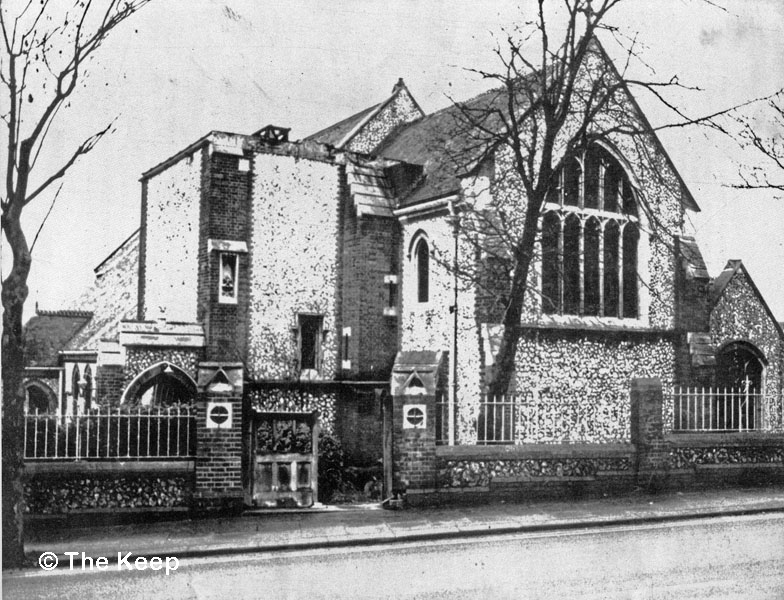
St Saviour's Church viewed across Ditchling Road c1979.
As a final embellishment to this church which lacked only a tower, a special meeting of the Vestry in September 1904 agreed to the transfer of a gigantic reredos from Chichester Cathedral to St Saviours Church.
Early in the following year, after a four day journey by horse and cart, the reredos was installed. Designed in 1870 by Slater & Carpenter, it depicted the Ascension with life-size figures sculptured in a whitish marble-like material.
The reredos was twenty-one foot high, an ornamental screen, which depicts Christ with his disciples. It was made for the Cathedral by Slater and Carpenter in 1870, but it was not popular there, so it was installed in St Saviour's Church in Brighton.
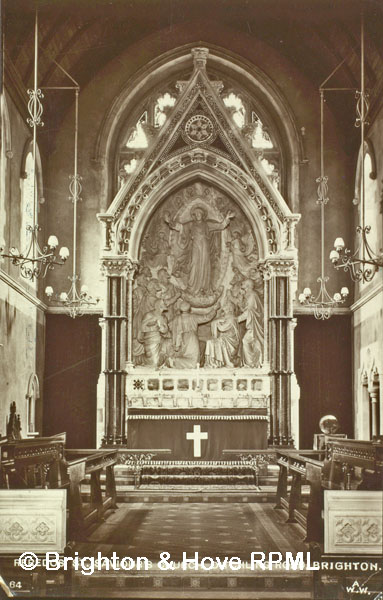
Reredos from Chichester Cathedral in the Sanctuary of St Saviours Church c1930. Ref: HA901514
The architect's original drawing show a proposed tower and broach-spire. A fund to complete the tower was in existence until 1963, but in the end, it never reached more than the first two stages. Maintenance repairs were a steady drain on resources and money from the Tower fund was often transferred to cope with necessary repairs "as long as it didn't break faith with the Donors".
In the post war period the church was plainly, but strikingly, redecorated; the reredos was looked at critically and eventually cleaned and given some colouring and illumination; and the south aisle was fitted out as a Lady Chapel. The provision of new frontal for the enlarged altar and the introduction of vestments completed the visual transformation of the building and its services.
Congregations increased and the sixties showed a very real strengthening of the Church.
However, people died, move house and change their jobs with less effort than it takes to fill the pews they vacate.
On 1 January 1978 a long forgotten proposal of 1950 was implemented and the parish merged with that of St. Augustine's.
The final stage in the life of St. Saviour's came when it was made a redundant church and nearly ninety nine years of Christian worship on the site moved to focus on St. Augustine's.
The stained glass windows, so lovingly saved for by the Sunday School Children or donated in memory of loved ones, were transferred to the west windows of St. Augustine's at a cost of £4,000. The reredos, originally brought from Chichester, returned to a museum there, it was with sadness that local residents witnessed the demolition of the Church that had for so long occupied the site in Ditchling Road.
Declining congregations caused the church to close in 1981; it was formally declared redundant from 1 November 1980. It was finally demolished in 1983.
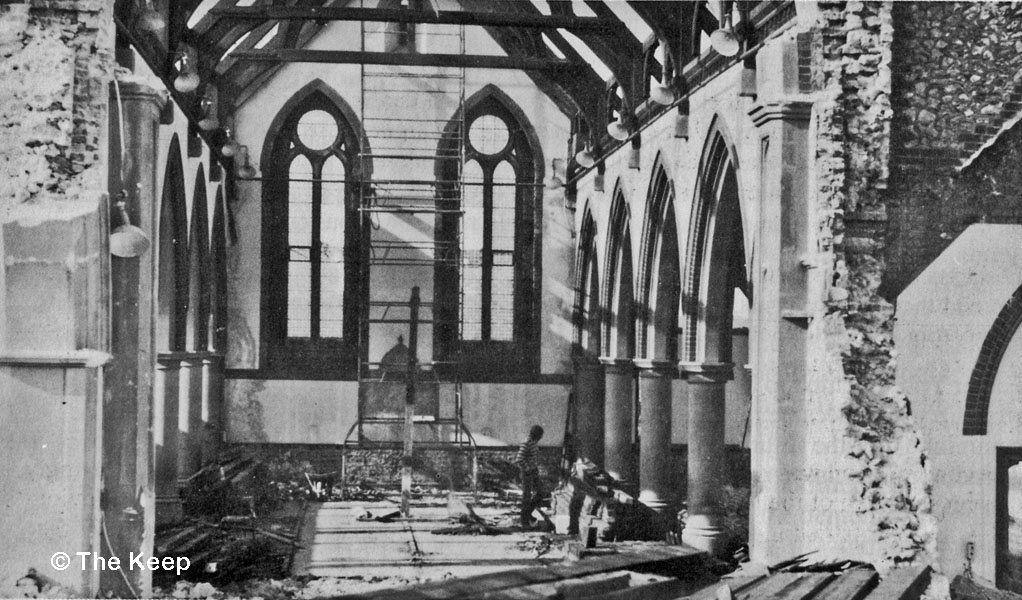
Demolition of St Saviours Church in 1983.
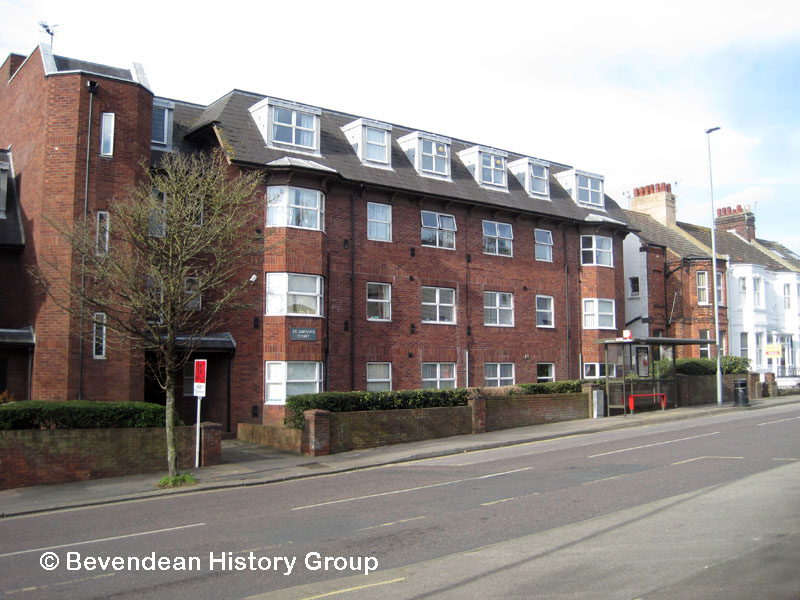
St Saviours Court a modern block of flats was built on the site of the church built about 1985 and photographed in 2022.
Ref: 2022-02-12_IMG_3773.
St Saviour's Mission Church
The four years of war had deep significance both at the time and later on. Church attendance fell, there was a predominance of women in the population while improved mobility and the dispersal of people to new estates tended to weaken longstanding links for St Saviour’s.
In 1920 it was decided to attach the New England Road Mission Church to St. Saviour's, so for the next forty years this was known as St. Saviour's Mission Church. This church was always largely supported by the railway families in the streets below the works. The church was an early casualty of a moving population when in the 1950's Brighton Council made compulsory purchase orders on all the small houses at the back of London Road.

A drawing showing the proposed church of St Saviour in Ditchling Road showing the church tower which was never built.
Ref: BHBox7b - © The Keep
St Saviour’s Church was built on a site donated by Mr Vere Fane Bennett-Stanford of Preston Manor, to the designs of Edmund Scott and F T Cawthorn of Regency Square, Brighton.
Here are the plans for St Saviours Church in Ditchling Road dated 24 February 1885.

Ground Plan for Proposed New Church in the Parish of Preston.
Ref: DB/D/134/4556

South Elevation for Proposed New Church in the Parish of Preston.
Ref: DB/D/134/4556-1

East and West Elevations for Proposed New Church in the Parish of Preston.
Ref: DB/D/134/4556-2

Site Plan for Proposed New Church in the Parish of Preston.
Ref: DB/D/134/4556-3

Section Plans for Proposed New Church in the Parish of Preston.
Ref: DB/D/134/4556-4

St Saviours Church viewed towards the Sanctuary c1915.
Ref: 1915-06_B&H Parochial Gazetteer

St Saviours’ Church viewed looking up Ditchling Road c1930 showing the squat tower.
A building committee raised £1,500 and constructed a crypt on the lower part of the site, where the first service was held on 17 July 1881.
Further work on the church was delayed but the foundation stone was laid on 19 August 1885, the nave and aisles were constructed in 1886, and the chancel was completed in 1889.
On Thursday 25 November 1886, the Bishop of Chichester consecrated the nave and aisles of the building and celebrated Holy Communion in the course of a service described as very long.
The six hundred seats in the new church were well filled and the collection amounted to £90, but it is worth noting that the number of communicants was just 78. A site near the foot of Ditchling Rise was acquired for a hall and adjacent mission house. These extensive premises were opened by the Bishop of Chichester in March 1887 and rapidly became a focus of community activities for more than fifty years.

St Saviours’ Church south side c1930.
St. Saviour's, unlike many other Victorian churches, did not have a single benefactor to erect and endow the building. The people living in the area were not wealthy and were unable to donate the large sums of money needed to complete the work.
Queen Victoria's Jubilee in June 1887 was the occasion for a special service and the church's first confirmation took place in December 1887. The five bays of the nave and aisles were closed at the east end by a temporary brick wall. By 1889 another building committee had been formed to initiate the completion of the Chancel, vestry and tower. The Chancel was finally consecrated in 1899.
St. Augustine's, begun in 1894 in an iron building only one-third of a mile away on the more fashionable side of the railway had serious consequences for the funding of the St Saviours church and from this period onwards the burden of debt loomed up to the 1930s.
The children in particular seem to have been vigorous fund raisers for the new church. Their efforts provided over the years the bell, the font and nearby window and brass fittings for the pulpit. The most outstanding gift by children of the Sunday School was the east window for the newly completed Chancel in 1899.
A few weeks later the organ was used for the first time, though it was not finally paid for until twelve years later.

St Saviour's Church viewed across Ditchling Road c1979.
As a final embellishment to this church which lacked only a tower, a special meeting of the Vestry in September 1904 agreed to the transfer of a gigantic reredos from Chichester Cathedral to St Saviours Church.
Early in the following year, after a four day journey by horse and cart, the reredos was installed. Designed in 1870 by Slater & Carpenter, it depicted the Ascension with life-size figures sculptured in a whitish marble-like material.
The reredos was twenty-one foot high, an ornamental screen, which depicts Christ with his disciples. It was made for the Cathedral by Slater and Carpenter in 1870, but it was not popular there, so it was installed in St Saviour's Church in Brighton.

The architect's original drawing show a proposed tower and broach-spire. A fund to complete the tower was in existence until 1963, but in the end, it never reached more than the first two stages. Maintenance repairs were a steady drain on resources and money from the Tower fund was often transferred to cope with necessary repairs "as long as it didn't break faith with the Donors".
In the post war period the church was plainly, but strikingly, redecorated; the reredos was looked at critically and eventually cleaned and given some colouring and illumination; and the south aisle was fitted out as a Lady Chapel. The provision of new frontal for the enlarged altar and the introduction of vestments completed the visual transformation of the building and its services.
Congregations increased and the sixties showed a very real strengthening of the Church.
However, people died, move house and change their jobs with less effort than it takes to fill the pews they vacate.
On 1 January 1978 a long forgotten proposal of 1950 was implemented and the parish merged with that of St. Augustine's.
The final stage in the life of St. Saviour's came when it was made a redundant church and nearly ninety nine years of Christian worship on the site moved to focus on St. Augustine's.
The stained glass windows, so lovingly saved for by the Sunday School Children or donated in memory of loved ones, were transferred to the west windows of St. Augustine's at a cost of £4,000. The reredos, originally brought from Chichester, returned to a museum there, it was with sadness that local residents witnessed the demolition of the Church that had for so long occupied the site in Ditchling Road.
Declining congregations caused the church to close in 1981; it was formally declared redundant from 1 November 1980. It was finally demolished in 1983.

Demolition of St Saviours Church in 1983.

St Saviours Court a modern block of flats was built on the site of the church built about 1985 and photographed in 2022.
Ref: 2022-02-12_IMG_3773.
St Saviour's Mission Church
The four years of war had deep significance both at the time and later on. Church attendance fell, there was a predominance of women in the population while improved mobility and the dispersal of people to new estates tended to weaken longstanding links for St Saviour’s.
In 1920 it was decided to attach the New England Road Mission Church to St. Saviour's, so for the next forty years this was known as St. Saviour's Mission Church. This church was always largely supported by the railway families in the streets below the works. The church was an early casualty of a moving population when in the 1950's Brighton Council made compulsory purchase orders on all the small houses at the back of London Road.
